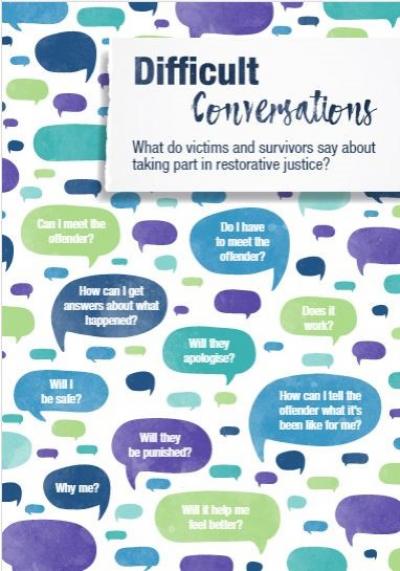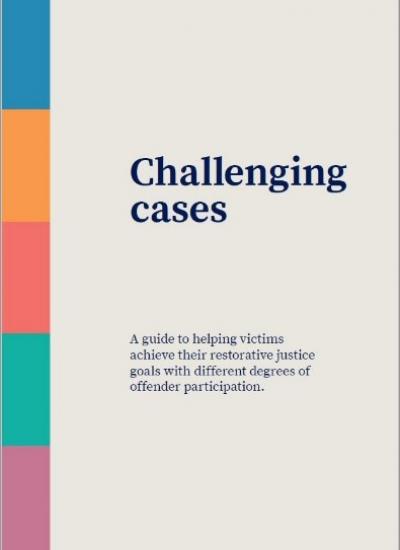Challenging cases: How collaborating with practitioners improved my research and led to a new practitioner guide for working with victims
When Thames Valley Partnership agreed to be the ‘collaborating institution’ for my PhD research back in 2015, neither of us were quite sure what that would involve. Luckily, they were willing to take a risk, and six years later the collaboration is still helping us improve both research and practice.
Posted:
Time to read:
Collaborating with practitioners improved my research
I needed help from Thames Valley Restorative Justice Service (TVRJS) to be able to conduct my research, because I needed the restorative justice facilitators to ask victims if they would be willing to be interviewed. So, I will confess that when I first arranged to regularly attend the TVRJS practitioner meetings, it was mainly to increase referrals for the research. I had been a practitioner in the criminal justice system prior to starting the PhD, and I was aware that I would need the facilitators to trust me. Although I am the kind of person who thinks research is very important, I remembered how I felt as a practitioner about academics who ‘swooped in’ with their questionnaires, and it was not positive! Having sometimes spent months developing a delicate rapport with service-users, I was usually hesitant to risk jeopardising that relationship for the sake of someone’s research – especially when in some cases the researchers had not even introduced themselves. This meant that when I started the PhD, I at least knew I needed to meet regularly with the TVRJS practitioners for them to get to know and trust me.
What I hadn’t anticipated was how useful those meetings would be for the research itself. Attending those meetings gave me insight into the issues the practitioners were facing, and what kind of research would be most useful. Yes, my initial plans were all well and good, the facilitators agreed it would be useful to document the changes that victims experienced through communicating with offenders. But what about the cases where the victims wanted to communicate but the offenders declined? What about the cases where victims and offenders wished to communicate with one another, but a criminal justice professional declared it too risky? These cases were much more common than I had realised, and I would need to include them if I wanted to understand the full range of victims’ experiences of restorative justice.
Attending those practice meetings enhanced the research more than any practitioner focus group I could have run. The meetings took place regularly, the conversation developed over the three years, and practitioners spoke freely about the issues they were facing and the emotional costs of the work they were doing. They asked one another better questions than I, as an outside researcher, would ever have asked them. I brought them themes that appeared to be emerging from the research, and they gave me valuable feedback: ‘yes I noticed that with a client last week’, or ‘I’ve not come across that before’.
How the research helped improve practice
I wanted this arrangement to be mutually beneficial of course, but before I started the research I wasn’t sure what I would add. In some desperation, I offered to take the minutes at the practitioner meetings! However, I was happy to learn that my research could be almost immediately useful. The practitioners were hungry for an outside perspective. I was of course careful not to breach the confidentiality I had promised my participants, but I was able to share with the facilitators what victims (in general) were saying about what was working and what was not working. I was also cautious not to tell the facilitators how to do their jobs, but they respected the data I was able to gather and asked for more input. I led some conversations about themes that were relevant to both their practice and my research. Most often, my findings suggested that victims were benefiting from the process and facilitators found this encouraging. Sometimes, my findings suggested that they could be doing something differently, and they were willing to take these challenges on board. In a positive feedback loop, the more useful the facilitators found my research to be, the more actively they asked victims to participate in the study.
An ongoing collaboration

First, we produced on a booklet for victims and survivors. Many of those I interviewed said they wanted to learn about others’ experiences before deciding whether to communicate with the offender. They didn’t want a ‘hard-sell’ or only to hear about the text-book ‘miraculous’ cases of restorative justice. They wanted to hear the full story – warts and all. That’s why in Difficult Conversations: What do victims and survivors say about taking part in restorative justice? (2019), we present victims’ reactions to logistical and emotional hurdles – from cancelled meetings to experiencing victim-blaming – as well as traditionally ‘successful’ cases. Interestingly, in many of these difficult cases victims still benefited from the restorative justice process depending on the preparation and support they received. The booklet can help victims know what to expect and prepare themselves for a variety of different outcomes.

Finally, for a live example of research and practice in conversation with one another, you can watch a recent joint presentation I gave with Dr Andrew Bates (forensic psychologist) and Helen Leney (TVRJS restorative justice practitioner) at The Mint House, Oxford Centre for Restorative Practice. Complexities of restorative justice in cases of sexual harm: learning from practice and research in the Thames Valley
.jpg)
